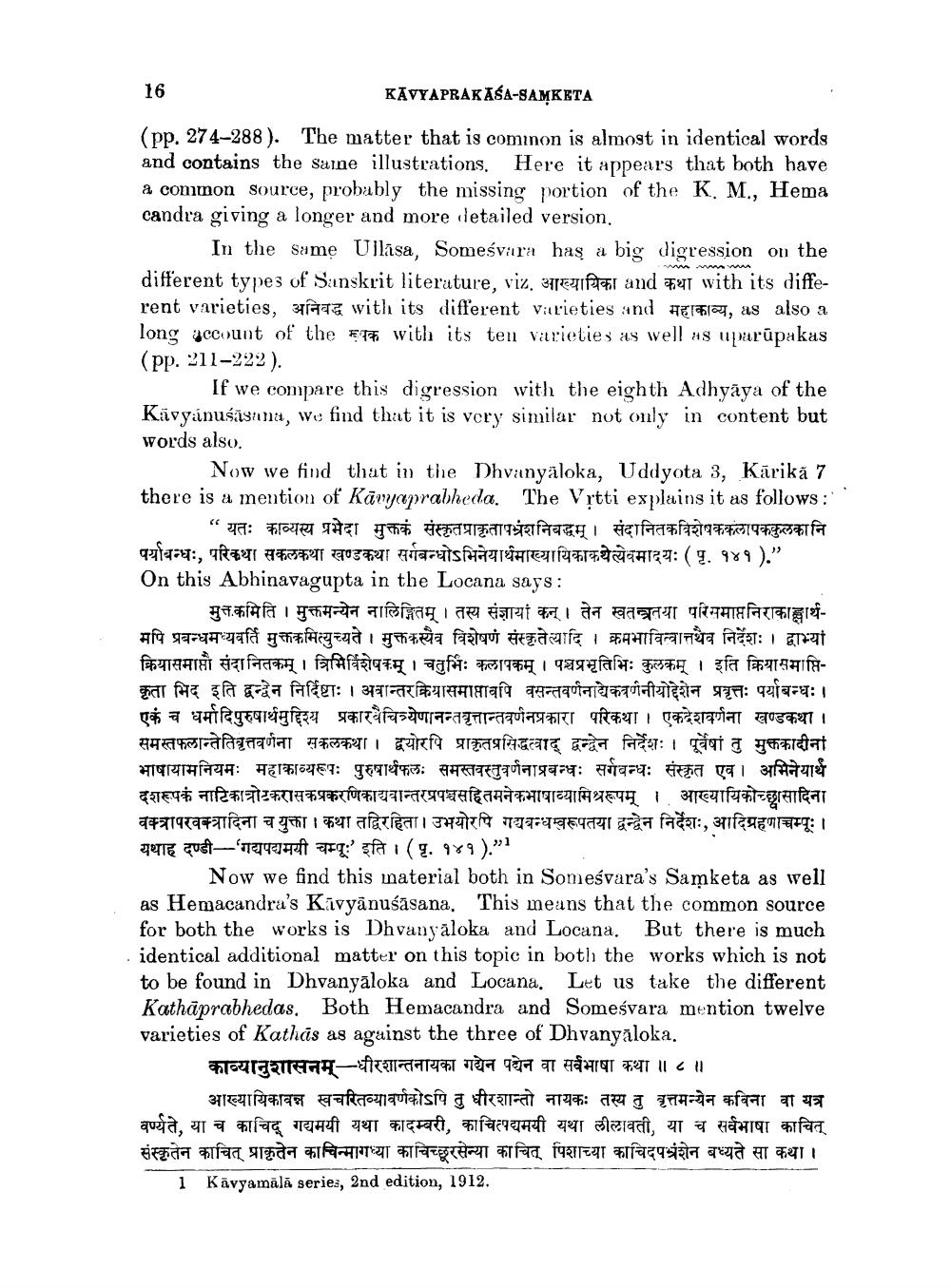________________
16
KĀVYAPRAKASA-SAMKETA
AnmM
(pp. 274–288). The matter that is cominon is almost in identical words and contains the saine illustrations. Here it appears that both have a common source, probably the missing portion of the K. M., Hema candra giving a longer and more detailed version.
In the same Ullāsa, Someśvara has a big digression on the different types of Sanskrit literature, viz. fpeift and #91 with its different varieties, अनिबद्ध with its different varieties and महाकाव्य, as also a long account of the Fi with its ten varieties as well as uparūpakas (pp.'11-222).
If we compare this digression with the eighth Adhyāya of the Kāvyánuśāsuna, we find that it is very similar not only in content but words also.
Now we find that in the Dhvanyaloka, Uddyota 3, Karika 7 there is a mention of Kāwyaprabheda. The Vrtti explains it as follows:
“यतः काव्यस्य प्रभेदा मुक्तकं संस्कृतप्राकृतापभ्रंशनिबद्धम्। संदानितकविशेषककलापककुलका नि पर्याबन्धः, परिकथा सकलकथा खण्डकथा सर्गबन्धोऽभिनेयार्थमाख्यायिकाकथेत्येवमादयः (पृ. १४१)." On this Abhinavagupta in the Locana says:
मुक्त कमिति । मुक्तमन्येन नालिङ्गितम् । तस्य संज्ञायां कन् । तेन स्वतन्त्रतया परिसमाप्त निराकाङ्क्षार्थमपि प्रबन्धमध्यवर्ति मुक्तकमित्युच्यते । मुक्तकस्यैव विशेषणं संस्कृतेत्यादि । क्रमभावित्वात्तथैव निर्देशः । द्वाभ्यां क्रियासमाप्तौ संदानितकम् । त्रिमिर्विशेषकम् । चतुर्भिः कलापकम् । पञ्चप्रभृतिभिः कुलकम् । इति क्रियासमाप्तिकृता भिद इति द्वन्द्वेन निर्दिष्टाः । अवान्तरक्रियासमाप्तावपि वसन्तवर्णनाद्येकवर्णनीयोद्देशेन प्रवृत्तः पर्याबन्धः । एकं च धर्मादिपुरुषार्थमुद्दिश्य प्रकारवैचित्र्येणानन्तवृत्तान्तवर्णनप्रकारा परिकथा । एकदेशवर्णना खण्डकथा । समस्तफलान्तेतिवृत्तवर्णना सकलकथा। द्वयोरपि प्राकृतप्रसिद्धत्वाद् द्वन्द्वेन निर्देशः । पूर्वेषां तु मुक्तकादीनां भाषायामनियमः महाकाव्यरूपः पुरुषार्थफलः समस्तवस्तुवर्णनाप्रबन्धः सर्गबन्धः संस्कृत एव। अभिनेयार्थ दशरूपकं नाटिकात्रोटकरासकप्रकरणिकाद्यवान्तरप्रपञ्चसहितमनेकभाषाव्यामिश्ररूपम् । आख्यायिकोच्छ्रासादिना वक्त्रापरवक्त्रादिना च युक्ता । कथा तद्विरहिता। उभयोरपि गद्यबन्धस्वरूपतया द्वन्द्वेन निर्देशः, आदिग्रहणाच्चम्पूः । यथाह दण्डी--'गद्यपद्यमयी चम्पू:' इति । (पृ. १४१)."]
Now we find this material both in Someśvara's Saņketa as well as Hemacandra's Kūvyānusāsana. This means that the common source for both the works is Dhvanyaloka and Locana. But there is much identical additional matter on this topic in both the works which is not to be found in Dhvanyaloka and Locana. Let us take the different Kathaprabhedas. Both Hemacandra and Someśvara mention twelve varieties of Kathas as against the three of Dhvanyaloka.
काव्यानुशासनम्-धीरशान्तनायका गद्येन पद्येन वा सर्वभाषा कथा ।। ८ ।
आख्यायिकावन्न स्वचरितव्यावर्णकोऽपि तु धीरशान्तो नायकः तस्य तु वृत्तमन्येन कविना वा यत्र वर्ण्यते, या च काचिद् गद्यमयी यथा कादम्बरी, काचित्पद्यमयी यथा लीलावती, या च सर्वभाषा काचित् संस्कृतेन काचित् प्राकृतेन काचिन्मागध्या काचिच्छूरसेन्या काचित् पिशाच्या काचिदपत्रंशेन बध्यते सा कथा।
1 Kavyamala series, 2nd edition, 1912.




